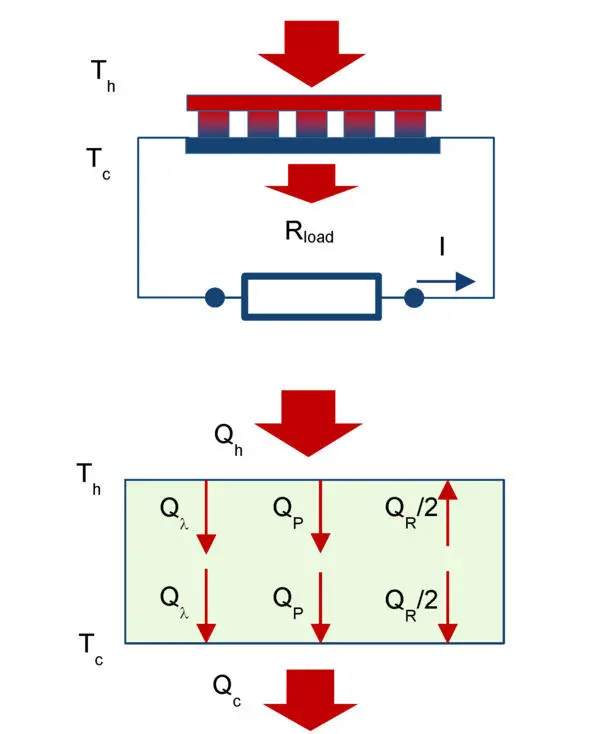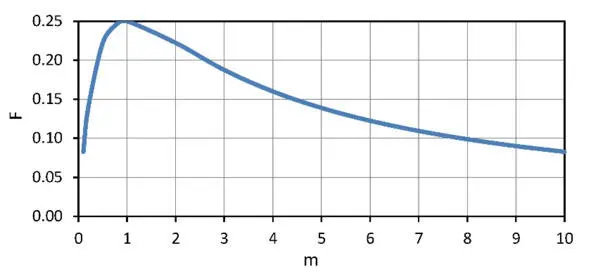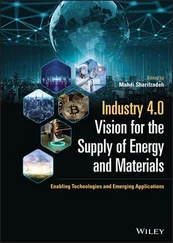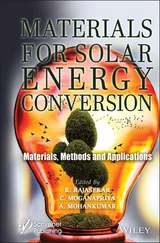Heat balance equations of thermoelectric module in generating mode (Fig. 2.2) are the following.

where Q h – heat flow absorbed by the hot side of the module; Q c – heat flow emitted by the cold side of the module; Q λ – heat conducted due to thermal conductivity; Q P – heat transferred due to the Peltier effect; Q R – Joule heat emitted due to the electric current in a closed circuit of the generator.

Figure. 2.2 Heat flow diagram for generating mode.
If to neglect temperature dependences of physical parameters, then heat balance equations in the generator mode can be written as the following:

where T h , T c – temperatures of the hot and cold sides of generator module, respectively; N – number of pairs of thermoelements (pellets) in the module; α – average value of thermal motive force (thermoEMF), other words – Seebeck coefficient of pair of pellets n- and p- type; k -average heat conductivity of the pellet pair; Δ T – temperature difference ( Δ T=T h-T c ) ; I – electric current through the module.
Here and below average values α , k , R are used – average values of paired thermoelements (pellets) of n-and p-type. For example, α= (α n+α p) /2 . And these parameters refer to average operating temperature of pellets, in situations where the temperature dependency properties can generally be neglected.
Thermoelectromotive force (ThermoEMF) E of a thermoelectric generator depends on the temperature difference ΔT , number of thermoelements N and Seebeck coefficient α as the following

We introduce the notation for internal resistance of thermoelectric generator ACR=2NR , and for external load resistance – R load .
Electric current through the generator is determined by thermoEMF E and total resistance of closed circuit (Fig. 2.2):

Here we introduce important parameter m – the ratio of the external load R load to internal resistance of generator module ACR .

From the balanced equation (2.5) and (2.6) one can find that:

First member EI of the difference (2.10) is the total heat that is converted into electric current by the thermoelectric generator. The second member I 2ACR is what part which comes back into heat due to the Joule effect.
– When the difference (2.10) is equally to zero (short circuit mode, external load resistance equal to zero) then all the converted energy comes back into heat.
– When the difference is positive (there is non-zero external load), i.e. the generator converts heat into electricity.
With given ratios (2.7) – (2.9) the balance equations (2.3) and (2.4) can be rewritten as the follows:

where Z – Figure-of-Merit of thermoelectric module; Q λ – heat flow due to thermal conductivity through the module (Q λ=2NkΔT).
Here the heat transferred through the Peltier effect Q P

Joule heat Q λ

Voltage U in external circuit, taking into account (2.8), is the following.

Power P in the external circuit (converted power).

Here an important dimensionless factor F is appeared.

Formula (2.16) has a maximum defined by the dimensionless factor F , its dependence on the ratio m (2.9) of load resistance R load and internal resistance ACR of generator module (Fig. 2.3).

Figure 2.3 Dependence of dimensionless factor F from ratio m=R load/ACR.
Maximum F and, respectively (2.16), maximum power P are achieved when m= 1, i.e.

Important note – maximum power P max that can be obtained by a thermoelectric generator module is only one quarter of the power converted by the module in short circuit mode.

Electric current through the module in maximum power mode I max at m =1 is the following

The thermoelectric generator efficiency η

Taking into account formulas (2.7), (2.11) and (2.16) one can find that

Investigating the formula for maximum at fixed temperature T h and Δ T ( T h, Δ T=const ), we obtain formula for maximum efficiency η (optimal mode for efficiency):
Читать дальше































